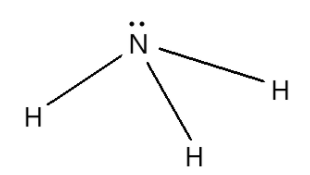
Statement I: Ammonia has a trigonal pyramidal molecular geometry.
Statement II: Ammonia has a tetrahedral electron pair geometry with the three atoms bonded to the central atom.
A. True, true, correct explanation
B. True, true, not correct explanation
C. True, false
D. False, true
Answer
566.4k+ views
Hint: Ammonia is a compound with one nitrogen atom as centre and three hydrogen atoms connected to it. It has three bond pairs of electrons and one lone pair of electrons.
Complete step by step answer:
Before answering this question we need to know everything about ammonia.
Ammonia is a compound of nitrogen and hydrogen with the formula $N{H_3}$ . It is a stable binary hydride and the simplest pnictogen hydride. It is a colourless gas with a characteristic pungent smell. It is a nitrogenous waste particularly among aquatic organisms and it contributes significantly to the nutritional needs of terrestrial organisms by serving as a predecessor to food and fertilizers. It is directly or indirectly a building block for the synthesis of many pharmaceutical products and is used in many commercial cleaning products. It is both caustic and hazardous in its concentrated form. It is classified as an extremely hazardous substance in the United States and is also subject to strict reporting requirements by facilities which produce, store or use it in significant quantities.
The structure of ammonia is as given below,

The ammonia molecule has a trigonal pyramidal shape as predicted by the valence shell electron pair repulsion theory with a bond angle of ${106.7^ \circ }$ which is experimentally determined. The central atom nitrogen has five outer electrons with an additional electron from each hydrogen atom. This gives a total of eight electrons or four electron pairs that are arranged in tetrahedral geometry. Three of these electron pairs are used as bond pairs which leaves one lone pair of electrons. The lone pair repel more strongly than bond pairs giving tetrahedral arrangement. Since the lone pairs are invincible the shape of ammonia is trigonal pyramidal.
Now, according to the question both the statements are correct as it has trigonal geometry and a tetrahedral electron pair with three atoms bonded to the central atom.
Therefore, option A is correct.
Note:
Ammonia has four electron pairs and its geometry is based on tetrahedral arrangement of electron pairs. It has three bonded groups and one lone pair. The shape of ammonia is trigonal pyramidal.
Complete step by step answer:
Before answering this question we need to know everything about ammonia.
Ammonia is a compound of nitrogen and hydrogen with the formula $N{H_3}$ . It is a stable binary hydride and the simplest pnictogen hydride. It is a colourless gas with a characteristic pungent smell. It is a nitrogenous waste particularly among aquatic organisms and it contributes significantly to the nutritional needs of terrestrial organisms by serving as a predecessor to food and fertilizers. It is directly or indirectly a building block for the synthesis of many pharmaceutical products and is used in many commercial cleaning products. It is both caustic and hazardous in its concentrated form. It is classified as an extremely hazardous substance in the United States and is also subject to strict reporting requirements by facilities which produce, store or use it in significant quantities.
The structure of ammonia is as given below,

The ammonia molecule has a trigonal pyramidal shape as predicted by the valence shell electron pair repulsion theory with a bond angle of ${106.7^ \circ }$ which is experimentally determined. The central atom nitrogen has five outer electrons with an additional electron from each hydrogen atom. This gives a total of eight electrons or four electron pairs that are arranged in tetrahedral geometry. Three of these electron pairs are used as bond pairs which leaves one lone pair of electrons. The lone pair repel more strongly than bond pairs giving tetrahedral arrangement. Since the lone pairs are invincible the shape of ammonia is trigonal pyramidal.
Now, according to the question both the statements are correct as it has trigonal geometry and a tetrahedral electron pair with three atoms bonded to the central atom.
Therefore, option A is correct.
Note:
Ammonia has four electron pairs and its geometry is based on tetrahedral arrangement of electron pairs. It has three bonded groups and one lone pair. The shape of ammonia is trigonal pyramidal.
Recently Updated Pages
Why are manures considered better than fertilizers class 11 biology CBSE

Find the coordinates of the midpoint of the line segment class 11 maths CBSE

Distinguish between static friction limiting friction class 11 physics CBSE

The Chairman of the constituent Assembly was A Jawaharlal class 11 social science CBSE

The first National Commission on Labour NCL submitted class 11 social science CBSE

Number of all subshell of n + l 7 is A 4 B 5 C 6 D class 11 chemistry CBSE

Trending doubts
10 examples of friction in our daily life

One Metric ton is equal to kg A 10000 B 1000 C 100 class 11 physics CBSE

Difference Between Prokaryotic Cells and Eukaryotic Cells

1 Quintal is equal to a 110 kg b 10 kg c 100kg d 1000 class 11 physics CBSE

State the laws of reflection of light

Explain zero factorial class 11 maths CBSE




